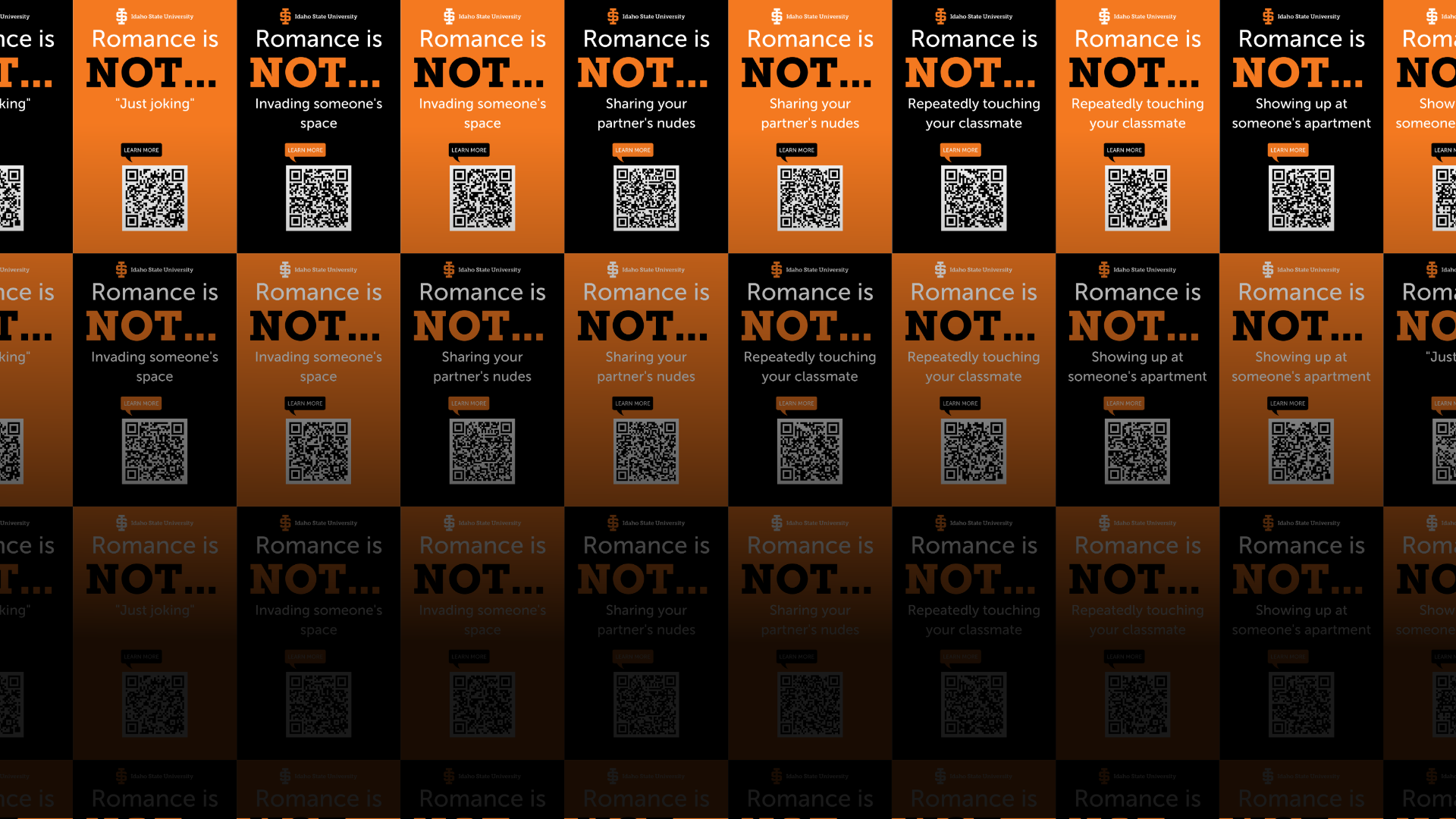A Title IX Campaign To Educate on Harmful, But Normalized Behaviors
Have you noticed the orange and black posters around campus? Beginning in April 2023 for Sexual Assault Awareness Month the Title IX Office has begun running a campaign to address some of the less discussed behaviors in dating and student life that are normalized but harmful.
Each poster has a QR code that links to a story providing context for the behavior mentioned on the poster, as well as a small written section that gives additional information explaining why the actions in the story are harmful. You can also access these stories on this website.
-500x385.png)
The goals of this campaign are to encourage more discussion around dating and romance as well as call out certain behaviors that people may do that are normalized but cause harm. While the actions shared via the posters may seem minor at first, they can lead to unsafe situations. It is everyone's responsibility to engage in healthy behaviors. Recognizing when behaviors are becoming harmful can be the first step to developing healthy relationships or leaving situations that have become too harmful.
If you are dealing with experiences similar to the ones mentioned in this campaign, resources are available and linked at the bottom of this page.
Stories
The links below will show you a story depicting an example of a harmful behavior and show where this behavior can lead if not addressed.
Harmful Behaviors
Stalking is a pattern of behavior directed at a specific person that would cause a reasonable person to fear for the person’s safety or the safety of others; or suffer substantial emotional distress. ISU Policy defines this as:
- Engaging in a course of conduct on the basis of sex directed at a specific person, that would cause a reasonable person to fear for the person’s safety, or the safety of others, or suffer substantial emotional distress. For the purposes of this definition:
- Course of conduct means two (2) or more acts, including, but not limited to acts in which the Respondent directly, indirectly, or through third parties, by any action, method, device, or means, follows, monitors observes, surveils, threatens, or communicates to or about a person, or interferes with a person’s property.
- Reasonable person means a reasonable person under similar circumstances and with similar identities to the Complainant.
- Substantial emotional distress means significant mental suffering or anguish that may but does not necessarily require medical or other professional treatment or counseling.
Coercion is a type of force. ISU policy explains how coercion is applied to overcome an objection to sexual activity.
- Force is the use of physical violence and/or physical imposition to gain sexual access. Force also includes threats, intimidation (implied threats), and coercion that is intended to overcome resistance or produce consent.
- Sexual activity that is forced is, by definition, non-consensual, but nonconsensual sexual activity is not necessarily forced. Silence or the absence of resistance alone is not consent. Consent is not demonstrated by the absence of resistance. While resistance is not required or necessary, it is a clear demonstration of non-consent.
- Coercion is unreasonable pressure for sexual activity. Coercive conduct differs from seductive conduct based on factors such as the type and/or extent of the pressure used to obtain consent.
Sexual harassment includes unwelcome sexual advances, requests for sexual favors, and other verbal or physical harassment of a sexual nature in the workplace or learning environment. ISU and Title IX define this as:
- Sexual Harassment, as an umbrella category, includes offenses of sexual harassment, sexual assault, domestic violence, dating violence, and stalking, and is defined as conduct on the basis of sex that satisfies one or more of the following:
- Quid Pro Quo is defined as an employee of the University conditioning the provision of an aid, benefit, or service of the University on an individual’s participation in unwelcome sexual conduct; and/or
- Sexual Harassment is defined as unwelcome conduct determined by a reasonable person to be so severe and pervasive and objectively offensive, that it effectively denies a person equal access to the University’s education program or activity.
- Sexual assault
This list is not all-inclusive and any unwanted sexual attention or exposure to sexual content in the workplace or educational environment will be addressed by the Title IX office.
Emotional abuse is highlighted in this campaign as a possible precursor to domestic and dating violence. ISU Policy defines dating/domestic violence below:
- Dating Violence defined as violence on the basis of sex committed by a person who is in or has been in a social relationship of a romantic or intimate nature with the Complainant.
- Domestic Violence defined as violence on the basis of sex committed by a current or former spouse or intimate partner of the Complainant, by a person with whom the Complainant shares a child in common, or by a person who is cohabitating with, or has cohabitated with, the Complainant as a spouse or intimate partner, or by a person similarly situated to a spouse of the Complainant under the domestic or family violence laws of the state of Idaho or by any other person against an adult or youth Complainant who is protected from that person’s acts under the domestic or family violence laws of the state of Idaho.
Sexual Exploitation is defined as taking non-consensual or abusive sexual
advantage of another for their own benefit or for the benefit of anyone other
than the person being exploited, and that conduct does not otherwise
constitute sexual harassment under this policy. Examples of Sexual
Exploitation include, but are not limited to:
- Sexual voyeurism (such as observing or allowing others to observe a person undressing or using the bathroom or engaging in sexual acts without consent of the person being observed)
- Invasion of sexual privacy
- Taking pictures, video, or audio recording of another in a sexual act, or in any other sexually-related activity when there is a reasonable expectation of privacy during the activity, without the consent of all involved in the activity, or exceeding the boundaries of consent (such as disseminating sexual pictures without the photographed person’s consent), including the making or posting of revenge pornography
- Prostituting another person
- Engaging in sexual activity with another person while knowingly infected with human immunodeficiency virus (HIV) or a sexually transmitted disease (STD) or infection (STI), without informing the other person of the infection
- Causing or attempting to cause the incapacitation of another person (through alcohol, drugs, or any other means) for the purpose of compromising that person’s ability to give consent to sexual activity, or for the purpose of making that person vulnerable to non-consensual activity
- Misappropriation of another person’s identity on apps, websites, or other venues designed for dating or sexual connections
- Forcing a person to take an action against that person’s will by threatening to show, post or share information, video, audio, or an image that depicts the person’s nudity or sexual activity
- Knowingly soliciting a minor for sexual activity
- Engaging in sex trafficking
- Creation, possession, or dissemination of child pornography
Acknowledgement
This project was developed by Maya Miller
Maya is the Assistant to the Title IX Coordinator for outreach and education.
A special thank you to Dr. Deirdre Caputo-Levine, Dr. DJ Williams, and Dr. Jona Jacobson for their consultation and feedback in developing this campaign.
IF YOU NEED HELP
If you have found any of this content relatable and you would like to get help with a situation you are in or to begin to address the harmful behaviors you may be exhibiting click on the links below.


